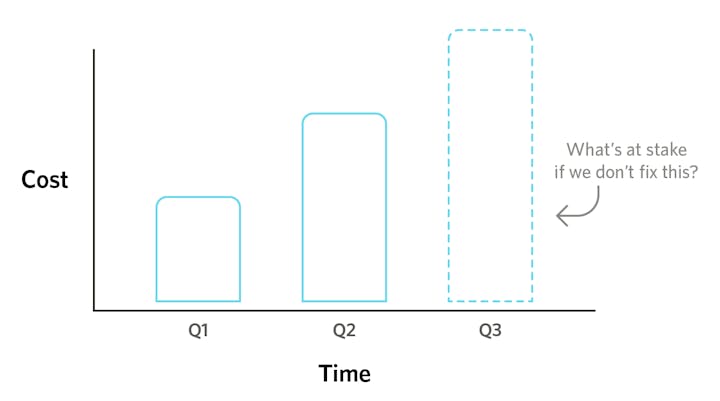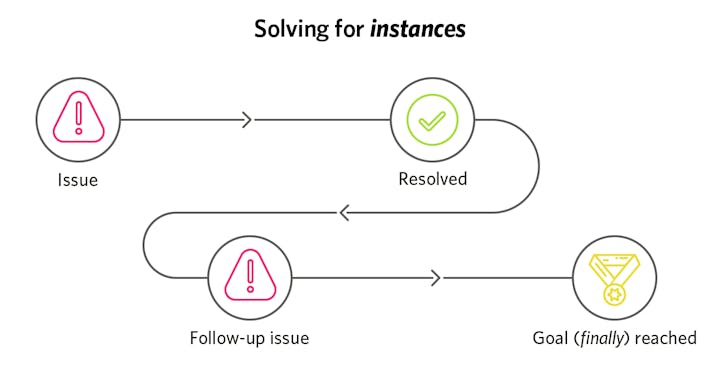4 Ways to Find Meaningful Opportunities in Customer Support


To build a great customer experience, occasionally you need to stop working in support and start working on support, as Lance Hendrickson shared at SupConf.
When trading the granular for the global, it’s often more effective to view the big picture through a new lens. Frameworks — what you might call a codified approach — can give you a structured way to assess where you are, spot new opportunities, and shake up your thinking.
Fortunately, there are a number of practical frameworks that can help you re-think how you provide support.
Try the customer support platform your team and customers will love
Teams using Help Scout are set up in minutes, twice as productive, and save up to 80% in annual support costs. Start a free trial to see what it can do for you.
Try for free
1. Link new activities to outcomes
In his book Customer Experience 3.0, John Goodman says support teams should create goals that link process (new initiatives) with outcome (resulting impact). Otherwise, you risk setting goals that are more means than end — an improved response time is great, but what’s the long-term significance for you and your customers?
Process goals track the new initiatives you start, like moving to 24/7 support or conducting an audit of your knowledge base.
Outcome goals measure the results of your initiatives with metrics linked to customer behavior, like rate of referrals and volume of complaints.
Financial goals tie the outcomes of your projects to the company’s finances, namely in revenue saved/earned and customer value.
Attribution is tricky, even for companies who are flush with data. As the saying goes, more fiction is written in Excel than Word. The value in Goodman’s framework lies in the concerted refocus from what we did in support to what impact we had on the business. The latter is where every department wants to be.
2. Take stock of your conversations
Bill Price, former Global VP of Customer Service at Amazon, created the pragmatic Value-Irritant matrix as a way for companies to take stock of incoming conversations. It was first shared in his book The Best Service Is No Service.
Its purpose is to get you to think critically about what types of conversations you're currently having, and how you can shift the ratio. To reduce low-value conversations, first figure out why customers are contacting you; tags and Custom Fields are useful for this. Price suggests a pair of questions to be raised when evaluating how you tag your conversations:
Are you using too many arbitrary categories? If the use of a specific tag suddenly increased, could you tell if it was due to valuable or irritable conversations? Seeing a rise in the “Payments” tag doesn’t reveal as much as a spike in “Payment error.”
Do you need to know what, or why? Amazon originally had “Shipping issue” (what happened) as one of their contact codes, but Price didn’t find it useful. They later split the category, using codes like “Late by shipper” and “Warehouse delays” (why it happened).
Remember, making changes to favor valuable conversations isn’t a selfish gesture. As Price’s matrix demonstrates, you can reduce the need for many types of contacts, saving both you and the customer time and energy.
3. Determine the cost of inaction

The fastest way to get something fixed is to show what’s at stake if it stays broken. Team leads understand this, but they often try to rest on the One True Metric for performance, as Chase Clemons points out.
Cost of Inaction can be a useful starting point because “what matters” will change over time. Your case should reflect what the company and the stakeholders care about today.
To make your case persuasive, connect your support team's current concerns with what’s at risk for the company — is it potential MRR? Expenses? Impending burnout and frustration? Adjoining priorities is how you drum up incentive and enthusiasm to get the right things fixed.
4. Engineer a better customer experience
Experience engineering, as proposed by Matthew Dixon, Nick Toman, and Rick DeLisi in The Effortless Experience, aims to make the soft skills of support more tactical. It consists of two core ideas: influencing customer perception when saying “no,” and solving the next issue to avoid unnecessary follow-ups. Let's examine the latter.
Solving the next issue
Here’s a common way to think about a new contact: the customer is doing something, they run into a problem, they email you, and you fix the problem. Take a victory sip from the ol' afternoon coffee, add a win to your First Contact Resolution rate, and move on.

But what if we thought in outcomes instead of instances? The customer might follow-up with another question related to their original goal. This time, they’re helped by someone else on the team. We count that as yet another “first contact resolved,” but the customer views it as “I had to contact you twice.”
Instead we should think about Next Issue Avoidance, says Nick Toman. How? By knowing when to view a conversation through an outcome-focused lens — what is the customer really trying to do? What are her next steps after this resolution? Can you help her before she asks? Can you remove roadblocks before she reaches them?

New perspective, new approach
Bertrand Russell once said, “In all affairs it's a healthy thing now and then to hang a question mark on the things you have long taken for granted.”
What I like about the approaches above is that they’re coherent ways to frame support problems rather than being stubbornly prescribed solutions. For best results, use them as hanging question marks for your own procedures — only when a question is asked can an improvement be made.
The Supportive Weekly: A newsletter for people who want to deliver exceptional customer service.